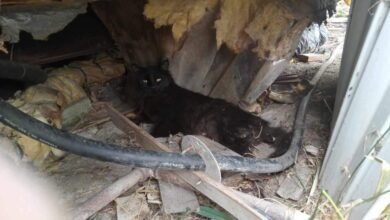On International Leopard Day, these shy big cats need us to end their commercial exploitation

Secretive and almost ghostly, leopards are rarely seen or heard, but they are the most far-ranging big cats, having historically thrived across much of Africa and Asia.
Powerful, intelligent and adaptable, these remarkable cats can persist in habitats ranging from deserts and rainforests to grasslands, high mountains, wetlands and snowy expanses of the Russian Far East. Particularly in South Asia, they have managed to survive in close proximity to humans, with nowhere as surprising an example as the high population density of leopards in the heart of Mumbai, one of the busiest megalopolises in the world.
Despite their adaptability, leopard populations are declining worldwide, with the International Union for Conservation of Nature downgrading their conservation status from Near Threatened to Vulnerable in 2016 – and anticipating future population declines.
Throughout their range, leopards are threatened by habitat destruction, loss of prey, conflicts with humans and poaching for body parts. Five of the Asian subspecies are categorized as Endangered or worse, with the Arabian leopard (P.p. nimr), Amur Leopard (P.p. orientalis) and Indo-Chinese leopard (P.p. delacouri) rated as Critically Endangered. In Southeast Asia, the Indo-Chinese leopard is estimated to have disappeared from more than 80% of its range since 2008, with extinctions occurring in Laos, Vietnam and Cambodia.
Targeted poaching for body parts is considered the main cause of the collapse of the leopard population in Southeast Asia.
Seizure data indicates that leopards are the most illegally hunted and traded among big cat species. Over the 10-year period from 2014 to 2023, reported incidents point to a minimum of 1,935 leopards seized in trade. More than 150 leopards were seized in trade in each of these years, with more than 200 reported to have been seized in 2018, 2020 and 2021, indicating a consistent and possibly increasing level of illegal trade.
Of note are two major seizures reported in Thailand, one in 2023 involving the seizure of 296 leopard parts and another in 2020 of over 800 pieces of leopard skin.

Leopard skins found for sale (c) EIA
India accounts for the majority (more than 50 percent) of reported seizures during these years, reflecting both the country’s relatively large leopard population and comparatively high levels of enforcement. Recognizing that there may be biases in the reporting and documentation of seizure data, it appears that, in comparison, Southeast Asian leopards have quietly disappeared from much of their range, with little evidence of measures to halt their decline.
Enforcement action is based on appropriate legislation to protect the species. By way of listing in Appendix I of the Convention on International Trade in Endangered Species of Wild Fauna and Flora (QUOTES), the international trade in leopards has been banned since 1975. Over the years, through CITES, the global community has recommended strong measures for countries to take to halt the decline of leopards. These measures include closing legal domestic markets for leopards that contribute to poaching and illegal trade, removing references to leopard parts and derivatives from the official pharmacopoeia, and working with communities and traditional medicine industries to gradually reduce and, eventually eliminate the use of leopard parts and derivatives.
Although most national legislation offers some level of protection to leopards, implementation of CITES recommendations by major countries leaves much to be desired. The CITES Secretariat warned about commercial threats to leopards in 1999, but this warning fell on deaf ears. In 2020, CITES Parties called for “more serious consideration” of threats to leopards, but in the absence of any response, the CITES Standing Committee in 2023 called on Parties to report on poaching, seizures and measures. conservation until February 2025.

Leopard skulls for sale in China (c) EIA
Leopards target almost every part of the body, but especially bones and skin. While there are other markets for leopard parts, demand in China is one of the main drivers of the global illegal leopard trade.
In 1993, the Chinese Ministry of Health approved the use of leopard bone as a substitute for tiger bone in traditional Chinese medicine (TCM). China’s Wildlife Protection Law allows licenses to be issued for commercial trade in leopards and a “special marking” scheme is applied to authorize legal trade in products containing the species.
In 2006, China issued regulations ordering that only existing stocks of leopard bone could be used for TCM and that no new stocks could be used. No information about the scale of these stocks is publicly available.
In 2014, the Government approved a brand of leopard bone wine as “intangible cultural heritage” and in 2018 approved the sale of 1,230.5kg of leopard bone to a company that manufactures it.
Last year, the EIA documented at least 38 TCM products online that displayed license numbers issued by China’s National Medical Products Administration.
Given the ban on international trade since 1975, China’s accession to CITES in 1981, and the small leopard population in China, it is unclear how the procurement of licensed leopard products is being met through legal supplies. When viewed in light of high global levels of poaching and illegal trade in the species, it seems clear that China’s regulations for leopards do not meet CITES recommendations for the species.

Through collaboration with World Animal Protection, we accessed shareholding data for relevant companies as of April 2024. While the composition of shareholding has changed, with some of the investors named in our report no longer holding shares, the overall picture has not improved. . In fact, as of last month, more than 100 financial institutions and banks based outside of China have invested in two of the TCM conglomerates that produce leopard bone products.
Like so many other threatened species, leopards face an uphill battle for their long-term survival. Anthropogenic threats in the form of habitat destruction, often leading to negative interactions between humans and leopards, can increase and reach country governments, the private sector and donors have much to do to address them.
What should be simpler to resolve is the continued exploitation of the species for its body parts. As a first step, this requires an unequivocal message from all interested parties, especially the governments of consumer states, that commercial trade in their parts and products will no longer be permitted or supported.
As a species, leopards are adaptable and built to endure – we should give them the best opportunity to do so.





